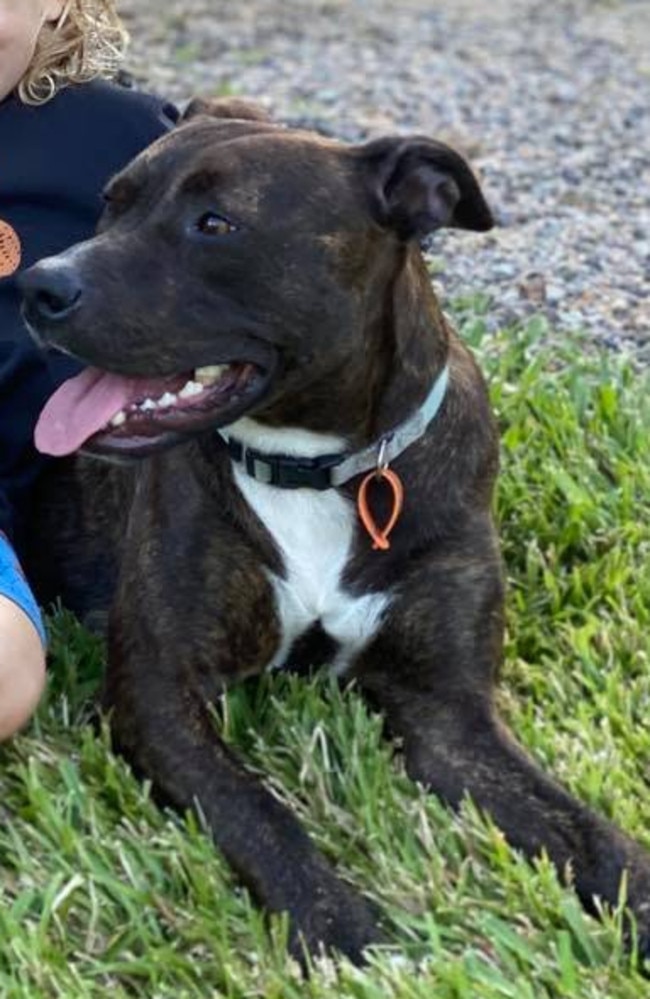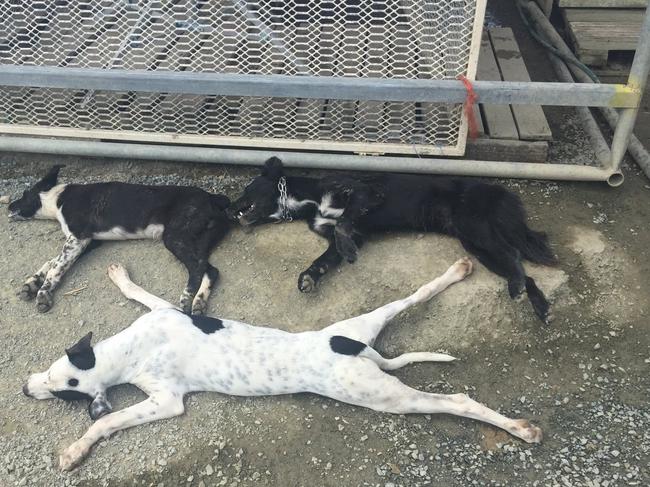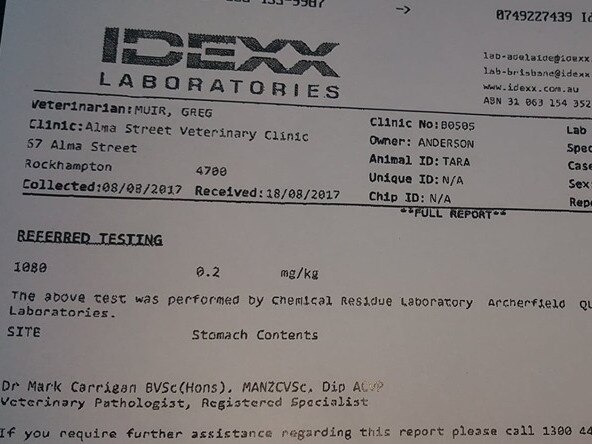Grieving pet owners want controversial baiting program banned
Convulsing and dying a horrific death, furious dog owners are demanding a controversial baiting program is banned with scores of beloved pets becoming ‘collateral damage’. One fed-up farmer has his dead dogs in a freezer after losing 15 in 15 years. WARNING: Distressing video and photos
QLD News
Don't miss out on the headlines from QLD News. Followed categories will be added to My News.
WARNING: DISTRESSING CONTENT
A groundswell of grieving pet owners are pushing for the end of a toxic pesticide used to kill feral animals following the sudden deaths of nine pet dogs in Queensland since August.
While many large property owners stand by the benefits of using sodium fluoroacetate, known by its brand name of 1080, to help protect livestock from wild dog attacks, other Australians have renewed calls for the chemical to be banned.
Amber Henderson, 36, from Ingham, said autopsy results proved her staffy cross, Zuma, died as a result of 1080 poisoning following a walk to the school bus stop on August 3.
Ms Henderson noticed Zuma eat something from the ground on the walk, but thought nothing of it.
A few hours later the one-year-old disappeared, before being found dead two days later.
“Someone in our area was using 1080 irresponsibly which led to the death of our beloved family pet,” she said.
Ms Henderson said there were no signs posted in the area, as were required under 1080 baiting legislation.

PUPPY’S TOUCHING GRAVESIDE VIGIL
The chemical is a highly toxic pesticide that is used to kill introduced pest animals such as rabbits, pigs, wild dogs, foxes, feral cats, and in some cases, native wildlife.
Though it has been banned in several countries, the toxin is used in Australia in forest and agricultural production areas, as well as for biodiversity conservation.
It has also been used effectively by some private landowners trying to protect their livestock from being killed or maimed by wild dogs.
But Ms Henderson and other opponents to the baiting method say there is too much “collateral damage” in the loss of other animals.

15 DOGS LOST IN 15 YEARS
Paul Anderson, from Australians Against 1080 and PAPP Poison, claims he has had 17 dogs poisoned and lost 15 of those working dogs to other people’s 1080-laced baits since 2005, across several different properties. He said the two dogs that survived had issues for the rest of their lives.
Fed up with losing so many valuable dogs, Mr Anderson decided to freeze some of the bodies after he lost seven dogs and puppies in a few hours in 2016.
He wanted to prove they were killed by 1080 baits he believed were thrown onto his Marmor property, outside of Rockhampton, and how long the toxin lasted once ingested.
Laboratory reports from two separate Rockhampton area vets show tests still found traces of 1080 in the system of both dogs in 2017.
Mr Anderson, 58, of Cardwell, said any government official was welcome to have the preserved dogs tested for the toxic pesticide.
“I put the six of them in the freezer. I still have three of them in the freezer, if someone wants to come along later and test them,” he said.
The property owner said he had a piece of dried meat tested following the deaths of the first three dogs on a property in Mt Fox, near Ingham, in 2005.
The meat sample returned positive for traces of 1080, according to the test results sighted by the Courier Mail.
Mr Anderson, who has never used the bait, said he had lost dogs to both strychnine and 1080 poisoning while living in Marmor, so he learnt to tell the difference in the way 1080 effected a dying animal.
He said “the way the dogs died” was completely different, depending on the type of poison ingested.
“When I came back from town that day, I found two of my Koolie puppies dead,” he said.
“About an hour later, a third pup started acting up and running under the caravan. The way she was carrying on, they want to wedge themselves in places you can’t get to. They want to hide because they’re terrified.”

There is no antidote for 1080 so Mr Anderson filmed some of his dogs dying from the poison in the hope it would help educate people.
“By then, I’d had a gut full,” he said.
“Nothing had been done over the years previously. I was sick of it all and the government wouldn’t do anything, Queensland Health wouldn’t do anything.
The pesticide is easily ingested by “non-target” animals because it is odourless, tasteless and colourless.
Other animals that lick the saliva or vomit from the infected dog can also die from secondary poisoning.
SAFE FOR NATIVE ANIMALS, EFFECTIVE FOR FARMERS
Many proponents of the bait state 1080 is essential for farmers, and that it is safe for most native animals.
A Biosecurity Queensland publication states many mammals, birds and reptiles have developed a much higher tolerance to 1080 than introduced animals, due to their evolution with naturally occurring fluoroacetate in some native plants.
Sarah Eaton, livestock manager for cattle properties in Kilcoy and Woodford, said her family was driven to use baits in the Moreton Bay region following the loss of 58 out of 60 calves from one paddock some years ago.
She said some feral dogs would wait for a pregnant cow to lie down to give birth, and would then kill the calf as it emerged.
“Sometimes you find a half-eaten calf hanging out of her,” she said.
“It’s a wonder more farmers don’t need psychiatrists.”
Since participating in the baiting program, the cattle farmers now only lose a couple of calves every other year.

Miss Eaton said her family adhere strictly to all the legislated 1080 guidelines and are frustrated by those who do not adhere to the baiting rules.
“Mismanagement of use is where the problems come from,” she said.
Greg Mifsud, national wild dog management co-ordinator for the Centre for Invasive Species Solutions (CISS) said wild dogs included dingoes, a dingo cross or domestic dogs on other people’s property attacking their livestock.
“They’ll kill calves on a regular basis and if they don’t kill them they can maim them. If not killed outright they’re never suitable or limited for sale,” the Toowoomba resident said.
“What’s also significant is people don’t understand the landholders and livestock breeders also experience a fair bit of emotional distress having to find their calves attacked.
“We undertake these control programs to protect life and people’s incomes and native wildlife.”
Mr Mifsud said there were significant safeguards required for the use of 1080 baiting, which included posting warning signs, distance restrictions and notifying neighbours ahead of time to avoid “non-target” animals, like pet dogs, eating the baits.
“Within southeast Queensland, those restrictions are more detailed and more complex than in other states … because we deal with more peri urban areas,” Mr Mifsud said.
“So when it comes to management control in those landscapes, it’s much greater. You have to send neighbours within a minimum of one kilometre notification, but a lot of shires go further and do two kilometres.”
Mr Mifsud said sodium fluoroacetate was used as it was found to be the safest product available for native animals and the environment.
“If we lose it our native species will be at serious risk of predation,” he said.
“It breaks down to harmless compounds when it dilutes with water, (at different rates) depending on the weather conditions.”
He said studies had proven many native animals, such as quolls, were unharmed by the toxin.
